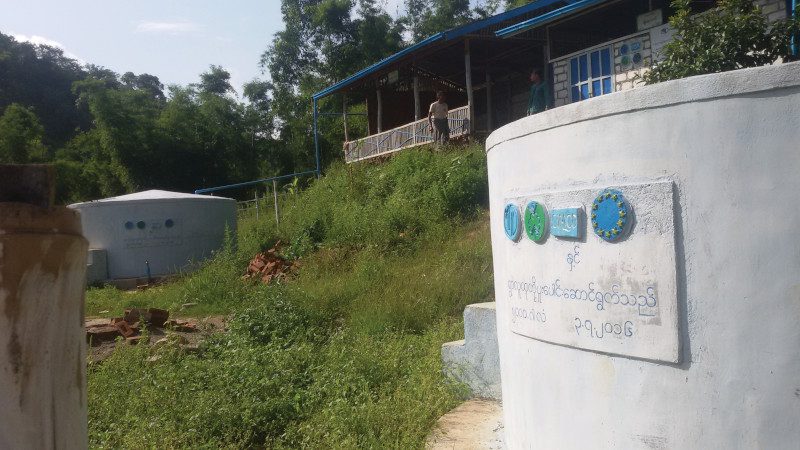This site uses cookies, as explained in our terms of use. If you consent, please close this message and continue to use this site.

Improved rainwater harvesting systems at household and community levels with larger storage capacity were demonstrated under ICIMOD’s Himalica initiative in villages in Myanmar that were facing acute water shortage. The traditional roof rainwater harvesting (RWH) systems at the household level were improved, new ponds constructed, and a few existing community ponds repaired (sediment excavated). Local communities now have much more water for drinking and sanitation purposes during the dry season. These measures have reduced the drudgery for women, as they spend less time and energy fetching water during the dry season. Communities are consuming more water by an average of 11 litres per capita per day (lpcd) in the wet season and 18 lpcd in the dry season, saving 1.5-2.0 hours per day and travelling around 2 km less to fetch water during the dry season.
The issue
In the Letmaunggwe Hills of Southern Shan State in Myanmar, many villages located on the tops and slopes of the hills are fully dependent on rainwater. In many villages, there are no ground water sources such as springs, tube wells, and bore wells. Therefore, the communities face acute water shortages for drinking and irrigation during the dry months. Most houses have private roof RWHs of about 100-200 litre capacity for storing drinking water during the rainy season (June-September). During the rest of the year, the people collect water from open community ponds. During the seven months of the year when water is in short supply (November–May), water collection requires a significant amount of time that could otherwise be spent on several productive activities. Households are forced to drink turbid water from open and contaminated community ponds. Waterborne diseases like stomach aches and diarrhoea are common in the villages. In some villages the same ponds used for bathing livestock are also used to source drinking water.
“We are happy to have community rainwater harvesting tanks with project (Himalica) support. Fetching water was such a tiring job. It took us 1 and a half hours to get water each day during the hot dry months. Now, we spend just 15 to 30 minutes to fetch water. Moreover, we have more time for farm activities, household work, and our children’s education. Our health is also improving because the water from the tanks is clean, compared to the open ponds’.”

The solution
Sustainable changes or improvements to existing water sources in these five villages required strong ownership by the local community. Therefore, to mobilize the community around water management, Water Management Committees (WMCs) were formed in six pilot villages. To build the capacity of project professionals and the Water Management Committee, hands-on practical training programmes on improved water management, WASH, and water-quality management were organized. Himalica also supported the WMCs to create rules and regulations for managing their available water resources. All new water harvesting systems were constructed with partial contributions from the participating families.
In addition to capacity-building and community mobilization, Himalica’s RWH project in six pilot villages – Pan Tin, Tha Yat Pin, Kyaung Nar, Kyaung Taung, Zee Yar, and Antpet, in Shan State – achieved the following:
Impact and uptake
Owing to the additional water harvesting structures, water consumption increased by an average of 18 lpcd and 11 lpcd during the wet and dry seasons, respectively. The RWH structures near the homesteads have not only increased water availability, but also improved livelihoods by alleviating the labour burden. In all villages during the dry season, 1.5–2.0 hours were saved by the water being available closer to home. The distance travelled to fetch water during the dry season was also reduced from an average of 2.7 km to 0.6 km. For women and children, this has been a welcome change, as they now have more time for recreational activities, reading, and writing.
The project’s efforts in water management have been complemented by the parallel efforts of private and government groups. The Department of Rural Development (DRD) supported a pumping water system to lift water from the Yan Chat Myaing Spring to the villages. The department installed a diesel pump, constructed a collection tank of 20,000 litre capacity at Yan Chan Myaing Spring, and established pipelines to distribute water to Pantin, Tayetpin, Kyaungnar, and Kyaung Taung villages. This water is collected in community tanks. Furthermore, a private donor worked with a local monk to pipe water from the Inmee Stream near Heho, which has served all project villages, and community tanks created with Himalica support have been used for storing this water supply.
Contributors
Madhav Prasad Dhakal, ICIMOD
Sanjeev Bhuchar, ICIMOD
David Abrahamson, MIID
Further reading
1) Htun, W. W., Burgess, C. & Dhakal, M. P. (2017, May 11) Women benefit most from rainwater harvesting systems at community level in Himalica pilot villages in Myanmar.
2) Dhakal, M. P. (2017, April 19): Water quality improvement options being explored in Himalica pilot sites in Myanmar.